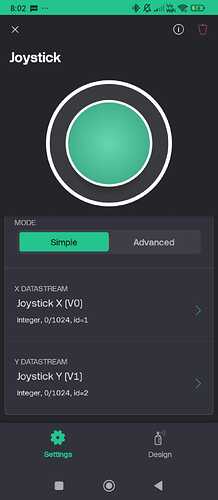The Y is always zero
Joystick X: 18, Y: 0
Backward Left
Joystick X: 18, Y: 0
Backward Left
Joystick X: 19, Y: 0
Backward Left
Joystick X: 22, Y: 0
Backward Left
Joystick X: 23, Y: 0
Backward Left
Joystick X: 24, Y: 0
Backward Left
Joystick X: 27, Y: 0
Backward Left
Joystick X: 28, Y: 0
Backward Left
Joystick X: 31, Y: 0
Backward Left
Joystick X: 34, Y: 0
Backward Left
Joystick X: 35, Y: 0
Backward Left
Joystick X: 36, Y: 0
Backward Left
Joystick X: 38, Y: 0
Backward Left
Joystick X: 39, Y: 0
Backward Left
#define BLYNK_PRINT Serial
#define BLYNK_TEMPLATE_ID ""
#define BLYNK_TEMPLATE_NAME ""
#include <WiFi.h>
#include <BlynkSimpleEsp32.h>
// WiFi credentials
char auth[] = "";
char ssid[] = "";
char pass[] = "";
// Motor control pins
#define IN_1 5
#define IN_2 18
#define IN_3 19
#define IN_4 21
#define En_A 23
#define En_B 22
// PWM setup
const int fixedSpeed = 100;
const int freq = 1000;
const int resolution = 8;
const int DEAD_ZONE = 50; // Increased dead zone for better stability
bool isOn = false;
BlynkTimer timer;
unsigned long lastJoystickTime = 0;
// === Movement Functions ===
void forward() {
Serial.println("Moving Forward");
digitalWrite(IN_1, LOW); digitalWrite(IN_2, HIGH); // Motor A
digitalWrite(IN_3, HIGH); digitalWrite(IN_4, LOW); // Motor B
ledcWrite(En_A, fixedSpeed);
ledcWrite(En_B, fixedSpeed);
}
void backward() {
Serial.println("Moving Backward");
digitalWrite(IN_1, HIGH); digitalWrite(IN_2, LOW); // Motor A
digitalWrite(IN_3, LOW); digitalWrite(IN_4, HIGH); // Motor B
ledcWrite(En_A, fixedSpeed);
ledcWrite(En_B, fixedSpeed);
}
void left() {
Serial.println("Turning Left");
digitalWrite(IN_1, LOW); digitalWrite(IN_2, LOW);
digitalWrite(IN_3, HIGH); digitalWrite(IN_4, LOW);
ledcWrite(En_A, 0);
ledcWrite(En_B, fixedSpeed);
}
void right() {
Serial.println("Turning Right");
digitalWrite(IN_1, LOW); digitalWrite(IN_2, HIGH);
digitalWrite(IN_3, LOW); digitalWrite(IN_4, LOW);
ledcWrite(En_A, fixedSpeed);
ledcWrite(En_B, 0);
}
void forwardRight() {
Serial.println("Forward Right");
digitalWrite(IN_1, LOW); digitalWrite(IN_2, HIGH);
digitalWrite(IN_3, LOW); digitalWrite(IN_4, LOW);
ledcWrite(En_A, fixedSpeed);
ledcWrite(En_B, fixedSpeed / 2);
}
void forwardLeft() {
Serial.println("Forward Left");
digitalWrite(IN_1, LOW); digitalWrite(IN_2, LOW);
digitalWrite(IN_3, HIGH); digitalWrite(IN_4, LOW);
ledcWrite(En_A, fixedSpeed / 2);
ledcWrite(En_B, fixedSpeed);
}
void backwardRight() {
Serial.println("Backward Right");
digitalWrite(IN_1, HIGH); digitalWrite(IN_2, LOW);
digitalWrite(IN_3, LOW); digitalWrite(IN_4, LOW);
ledcWrite(En_A, fixedSpeed);
ledcWrite(En_B, fixedSpeed / 2);
}
void backwardLeft() {
Serial.println("Backward Left");
digitalWrite(IN_1, LOW); digitalWrite(IN_2, LOW);
digitalWrite(IN_3, LOW); digitalWrite(IN_4, HIGH);
ledcWrite(En_A, fixedSpeed / 2);
ledcWrite(En_B, fixedSpeed);
}
void stop() {
Serial.println("Stopping");
digitalWrite(IN_1, LOW); digitalWrite(IN_2, LOW);
digitalWrite(IN_3, LOW); digitalWrite(IN_4, LOW);
ledcWrite(En_A, 0);
ledcWrite(En_B, 0);
}
// === Joystick Idle Check ===
void checkJoystickIdle() {
if (isOn && (millis() - lastJoystickTime > 200)) {
stop();
}
}
// === Setup ===
void setup() {
Serial.begin(115200);
Blynk.begin(auth, ssid, pass);
pinMode(IN_1, OUTPUT);
pinMode(IN_2, OUTPUT);
pinMode(IN_3, OUTPUT);
pinMode(IN_4, OUTPUT);
// Attach PWM with new API
ledcAttach(En_A, freq, resolution);
ledcAttach(En_B, freq, resolution);
stop();
Serial.println("Robot setup done!");
timer.setInterval(100, checkJoystickIdle);
}
// === Blynk Joystick (V0) ===
BLYNK_WRITE(V0) {
if (isOn) {
int x = param[0].asInt();
int y = param[1].asInt();
Serial.printf("Joystick X: %d, Y: %d\n", x, y);
lastJoystickTime = millis();
// Increased dead zone for both axes
if (abs(x - 512) < DEAD_ZONE && abs(y - 512) < DEAD_ZONE) {
stop(); // Neutral zone
}
else if (y >= 650 && x >= 650) {
forwardRight();
}
else if (y >= 650 && x <= 400) {
forwardLeft();
}
else if (y <= 400 && x >= 650) {
backwardRight();
}
else if (y <= 400 && x <= 400) {
backwardLeft();
}
else if (y >= 300) {
forward();
}
else if (y <= 300) {
backward();
}
else if (x >= 650) {
right();
}
else if (x <= 400) {
left();
}
} else {
stop();
}
}
// === Blynk Switch (V3) ===
BLYNK_WRITE(V3) {
isOn = param.asInt();
Serial.println(isOn ? "Robot is ON" : "Robot is OFF");
stop();
}
void loop() {
Blynk.run();
timer.run();
}
